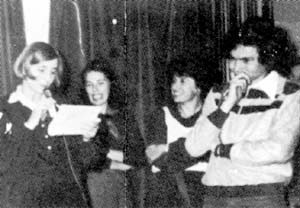This speech was opening the exhibition of György Galántai in the Artist's Club "Fészek" on the 24th of October 1978. It was written by András BÁN (Art critic), and read by Anna BANANA, who was in Budapest at that moment, doing her tour round Europe. She read it in Hungarian, even though she only speaks English.
Anna Banana is an important personality of the neo-dadaist movement. Her medias are festivals, performances, newspapers, stamps, mail-art etc. She is editor of the review called "Vile" which is a kind of anthology of dadaism and futurism. She has a great collection of everything in connection with bananas.)

ANNA BANANA: Kedves Barátaim!
A terem közepén öt tárgy látható. Közmegegyezés szerint ezek műtárgyak, mert művész alakította őket a mostani formájukra.
A tárgyak megnevezése:
- első változat – könyv-objektek,
- második változat – rézlemezvég-síksor összefogása nagyfeszültségű elektromos biztosíték alkatrészekkel.
A falon kétoldalt, pontos megfeleltetésben a tárgyak egy-egy lenyomata (porogram) látható. Galántai a tárgyak tetejére és egy oldalára lepedővásznat borított és festékszóró pisztollyal lefújta. Kivasalva, de keretezés nélkül akasztotta falra a vásznakat. A művész Bán Andrást kérte föl, hogy megnyissa ezt a kiállítást. Ő viszont engem, Anna Bananát kért meg, hogy szövegét felolvassam. Mégpedig azért, mert úgy véli, hogy Galántai egy modell működését kívánja kipróbálni ezen a kiállításon. S ha ez a modell jó, akkor működnie is kell. Azaz nemcsak a tárgyak lenyomata van ott a falakon, hanem a kiállítás lenyomata is rajtunk – így Bán Andráson is. Erről a következőket mondja:
BÁN ANDRÁS: The material of these objects comes from the industrial production. The biggest part of the sculpted material betrays its origin and its age too. This group of components, this exact functionality of the spiritless reminds us of the second half of the 20th century. The waist elements are joined and proportioned by Galántai with the same precisity, that is due to constructions still able to operate. He states thus, that these objects might work somehow even in this state. The industrial components get humanized while getting wrecked, and we can perceive them only when they become fragments. Galántai relies on this, when he does not exclude these spheres of humanity by the way of their fitting together – the first title of the work, book-objects is hinting to this. however, we should not ascribe too much of importance to the associations departing from the objects: we can get familiar with the fragments, wrecks too easily, we can recognise our own world in them with a superficial analogy. Much more important is the gesture, by wich Galántai distances again these object from us, making a print of them he transplants them to another sphere of insecurity, to the one of the art. The way he does this may seem a reminiscence to some of the spectators, but in fact it is only a systematic use of a contemporary code: the pseudo-surface which represents plasticity in the plane is used as a device mostly in connection with the value attributed to art. Galántai needed this multiple recording to be able to observe how this simple model works and what effects can it bring forth.
ANNA BANANA: Másodszor Bán András arra kért föl engem, hogy mondjam el, ez a mű milyen nyomokat hagyott bennem:
My personal comment is, I think the work is lovely but i don't think anybody understands what I am saying and I don't either.
Most pedig Önt kérném meg, hogy beszéljen nekünk erről, hogyan hatnak Önre ezek a tárgyak:
-anyone? – no comments?
És Ön milyen benyomásokkal távozik majd?
GALÁNTAI GYÖRGY: Jóval.
ANNA BANANA: Köszönöm. Természetesen egy mű milyensége nem mérhető azon, hogyan lehet szavakban újraformálni. Elegendő, ha a szándék arányában deformálja nézőit, hogy azok kivasalódva is viseljék a nyomát. Köszönöm a figyelmüket.